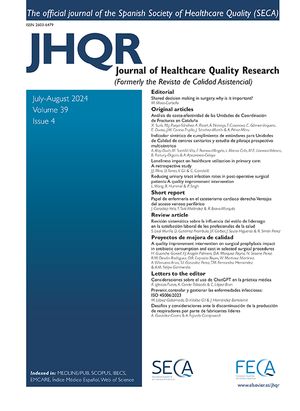El tratamiento de las neumonías adquiridas en la comunidad (NAC) con antibióticos en monoterapia y monodosis (MM) ha demostrado la misma efectividad clínica que las pautas clásicas de antibioterapia fraccionada, a la vez que disminuye la estancia hospitalaria. Esto hace que la MM constituya una opción de mejora. Objetivo: Comprobar si las características del tratamiento de las NAC con MM eran exportables a un hospital diferente de aquellos en los que se habían descrito inicialmente.
Material y métodoEstudio de intervención para la mejora de la calidad, en el período de enero a mayo de 1999. Tipo de muestreo: consecutivo. Datos recogidos: edad, sexo, puntuación APACHE II e índice de Charlson para comorbilidades, tiempo de estancia, mortalidad a 30 días, reingresos en los 10 días siguientes del alta hospitalaria, tiempos de enfermería en preparar y suministrar el tratamiento. En la etapa I se compararon las pautas de MM con levofloxacino o ceftriaxona frente a la pauta clásica de cefotaxima cada 6 h acompañada de un macrólido cada 12 h. En la etapa II se compararon entre sí las pautas de MM: levofloxacino frente a ceftriaxona. Durante todo el estudio se aplicaron guías de práctica clínica comunes a todos los pacientes con NAC. En la etapa III, según los resultados obtenidos y a las evidencias bibliográficas, el grupo de expertos seleccionó la pauta definitiva.
ResultadosEn la etapa I el tiempo medio ± desviación estándar (DE) de estancia de las NAC tratadas con MM fue de 151 ± 80,6 h frente a 204 ± 110,4 horas en el tratamiento clásico, siendo la diferencia estadísticamente significativa y clínicamente relevante. No se detectaron diferencias en la mortalidad y reingresos; el tiempo de enfermería fue de 4 min/paciente/día en la MM frente a 16 minutos en el tratamiento clásico. En la segunda etapa no se detectaron diferencias entre los dos tipos de MM empleadas, si bien no se alcanzó el tamaño adecuado de la muestra. El grupo de expertos seleccionó la MM con levofloxacino por permitir un tratamiento secuencial sin cambio de fármaco y porque su biodisponibilidad oral próxima al cien por cien permite iniciar el tratamiento oral rápidamente.
ComentarioNuestros resultados ponen de manifiesto que la MM supone una opción de mejora en nuestro hospital, dado que al disminuir los tiempos de estancia por paciente junto con un ahorro en el tiempo de enfermería mejora la utilización de las camas sin incrementar los riesgos para el paciente.
Antibiotics administered as monodose monotherapy (MM) for treatment of community-acquired pneumonia (CAP) is as effective as the classic dose-fractioned two-antibiotic regime. MM reduces hospital stay duration and can therefore be a better option.
AimTo analyze whether MM treatment of CAP, as indicated by previous studies, achieves a decrease in resource utilization while maintaining patient safety profiles.
Material and methodsQuality improvement study. Patients were consecutively allocated during January-May 1999. Age, sex, APACHE score, Charlson comorbidity score, mortality at 30 days, duration of hospitalization, number of re-admissions, nursing care time and antibiotic costs were recorded. In the first stage of the trial, levofloxacine or ceftriaxone MM were compared to the classic regime of cefotaxime every 6 hours in combination with a macrolide given every 12 hours. In the second stage, levofloxacine MM was compared to ceftriaxone MM. During the study, the same clinical practice guidelines were applied to all patients. In the third stage, the definitive regime was selected based on results obtained and bibliographic findings.
ResultsIn the first stage, the duration of hospitalization for MM patients was 151 ± 80.6 h compared to 204 ± 110.4 h for the combination regime patients, the difference being statistically significant. No statistically significant differences were found regarding mortality and readmission rates. The nursing care time was 4 min/patient/day for MM patients vs 16 min/patient/day for the combination regime patients. In the second stage the sample size was not sufficiently large to reveal differences between the two types of MM. Levofloxacine MM was prefered to ceftriaxone as no drug change was required in sequential treatment and also because its almost 100% bioavailability permits rapid initiation of oral treatment.
ConclusionsOur results show that MM for CAP represents an improvement for our institution, as it reduces hospitalization duration, nursing care time and expenditures, without increasing risk rates.






